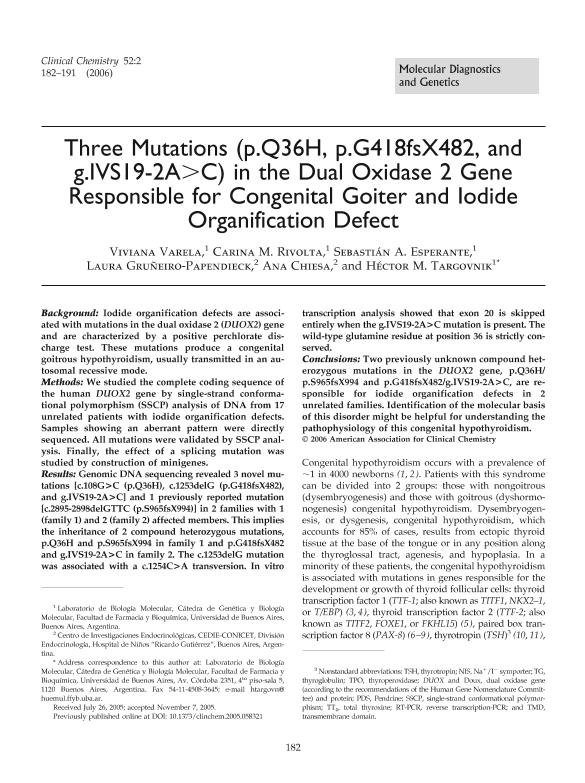Mostrar el registro sencillo del ítem
dc.contributor.author
Varela, Viviana

dc.contributor.author
Rivolta, Carina Marcela

dc.contributor.author
Esperante, Sebastian

dc.contributor.author
Gruñeiro Papendieck, Laura

dc.contributor.author
Chiesa, Ana Elena

dc.contributor.author
Targovnik, Hector Manuel

dc.date.available
2020-02-03T14:11:40Z
dc.date.issued
2006-02
dc.identifier.citation
Varela, Viviana; Rivolta, Carina Marcela; Esperante, Sebastian; Gruñeiro Papendieck, Laura; Chiesa, Ana Elena; et al.; Three mutations (p.Q36H, p.G418fsX482, and g.IVS19-2A>C) in the dual oxidase 2 gene responsible for congenital goiter and iodide organification defect; Oxford University Press; Clinical Chemistry; 52; 2; 2-2006; 182-191
dc.identifier.issn
0009-9147
dc.identifier.uri
http://hdl.handle.net/11336/96514
dc.description.abstract
Background: Iodide organisation defects are associated with mutations in the dual oxidase 2 (DUOX2) gene and are characterized by a positive perchlorate discharge test. These mutations produce a congenital goitrous hypothyroidism, usually transmitted in an autosomal recessive mode. Methods: We studied the complete coding sequence of the human DUOX2 gene by single-strand conformational polymorphism (SSCP) analysis of DNA from 17 unrelated patients with iodide organification defects. Samples showing an aberrant pattern were directly sequenced. All mutations were validated by SSCP analysis. Finally, the effect of a splicing mutation was studied by construction of minigenes. Results: Genomic DNA sequencing revealed 3 novel mutations [c.108G>C (p.Q36H), c.1253delG (p.G418fsX482), and g.IVS19-2A>C] and 1 previously reported mutation [c.2895-2898delGTTC (p.S965fsX994)] in 2 families with 1 (family 1) and 2 (family 2) affected members. This implies the inheritance of 2 compound heterozygous mutations, p.Q36H and p.S965fsX994 in family 1 and p.G418fsX482 and g.IVS19-2A>C in family 2. The c.1253delG mutation was associated with a c.1254C>A transversion. In vitro transcription analysis showed that exon 20 is skipped entirely when the g.IVS19-2A>C mutation is present. The wild-type glutamine residue at position 36 is strictly conserved. Conclusions: Two previously unknown compound heterozygous mutations in the DUOX2 gene, p.Q36H/ p.S965fsX994 and p.G418fsX482/g.IVS19-2A>C, are responsible for iodide organification defects in 2 unrelated families. Identification of the molecular basis of this disorder might be helpful for understanding the pathophysiology of this congenital hypothyroidism.
dc.format
application/pdf
dc.language.iso
eng
dc.publisher
Oxford University Press

dc.rights
info:eu-repo/semantics/openAccess
dc.rights.uri
https://creativecommons.org/licenses/by-nc-sa/2.5/ar/
dc.subject
CONGENITAL HYPOTHYROIDISM
dc.subject
MOLECULAR SEQUENCE DATA
dc.subject.classification
Genética Humana

dc.subject.classification
Medicina Básica

dc.subject.classification
CIENCIAS MÉDICAS Y DE LA SALUD

dc.title
Three mutations (p.Q36H, p.G418fsX482, and g.IVS19-2A>C) in the dual oxidase 2 gene responsible for congenital goiter and iodide organification defect
dc.type
info:eu-repo/semantics/article
dc.type
info:ar-repo/semantics/artículo
dc.type
info:eu-repo/semantics/publishedVersion
dc.date.updated
2019-04-22T14:09:27Z
dc.identifier.eissn
1530-8561
dc.journal.volume
52
dc.journal.number
2
dc.journal.pagination
182-191
dc.journal.pais
Reino Unido

dc.journal.ciudad
Oxford
dc.description.fil
Fil: Varela, Viviana. Universidad de Buenos Aires. Facultad de Ciencias Exactas y Naturales. Departamento de Química Biológica. Laboratorio de Biología Molecular; Argentina. Consejo Nacional de Investigaciones Científicas y Técnicas; Argentina
dc.description.fil
Fil: Rivolta, Carina Marcela. Universidad de Buenos Aires. Facultad de Ciencias Exactas y Naturales. Departamento de Química Biológica. Laboratorio de Biología Molecular; Argentina. Consejo Nacional de Investigaciones Científicas y Técnicas; Argentina
dc.description.fil
Fil: Esperante, Sebastian. Universidad de Buenos Aires. Facultad de Ciencias Exactas y Naturales. Departamento de Química Biológica. Laboratorio de Biología Molecular; Argentina. Consejo Nacional de Investigaciones Científicas y Técnicas; Argentina
dc.description.fil
Fil: Gruñeiro Papendieck, Laura. Consejo Nacional de Investigaciones Científicas y Técnicas. Oficina de Coordinación Administrativa Parque Centenario. Centro de Investigaciones Endocrinológicas "Dr. César Bergada". Gobierno de la Ciudad de Buenos Aires. Centro de Investigaciones Endocrinológicas "Dr. César Bergada". Fundación de Endocrinología Infantil. Centro de Investigaciones Endocrinológicas "Dr. César Bergada"; Argentina
dc.description.fil
Fil: Chiesa, Ana Elena. Consejo Nacional de Investigaciones Científicas y Técnicas. Oficina de Coordinación Administrativa Parque Centenario. Centro de Investigaciones Endocrinológicas "Dr. César Bergada". Gobierno de la Ciudad de Buenos Aires. Centro de Investigaciones Endocrinológicas "Dr. César Bergada". Fundación de Endocrinología Infantil. Centro de Investigaciones Endocrinológicas "Dr. César Bergada"; Argentina
dc.description.fil
Fil: Targovnik, Hector Manuel. Universidad de Buenos Aires. Facultad de Ciencias Exactas y Naturales. Departamento de Química Biológica. Laboratorio de Biología Molecular; Argentina. Consejo Nacional de Investigaciones Científicas y Técnicas; Argentina
dc.journal.title
Clinical Chemistry

dc.relation.alternativeid
info:eu-repo/semantics/altIdentifier/url/https://academic.oup.com/clinchem/article/52/2/182/5626804
dc.relation.alternativeid
info:eu-repo/semantics/altIdentifier/doi/http://dx.doi.org/10.1373/clinchem.2005.058321
Archivos asociados
